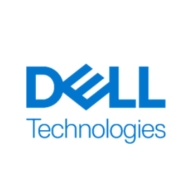


Dell PowerMax and HPE Alletra Storage compete in the enterprise storage solutions category. Dell PowerMax has an edge in performance and reliability due to its NVMe architecture and exhaustive feature set.
Features: Dell PowerMax features high-performance NVMe architecture, data compression, deduplication, and SRDF replication services, providing enhanced application performance and data availability. It also comes with REST API integration and Unisphere tools for efficient management. HPE Alletra Storage, on the other hand, is recognized for hybrid and private cloud capabilities, performing impressively for modern workloads, and comes equipped with InfoSight for performance insights and simplified storage management.
Room for Improvement: Dell PowerMax could improve its deduplication and compression ratios, support for NVMe over fabrics, and make the Unisphere interface more intuitive for better user management experience. Users also request better cloud integration and streamlined automation. For HPE Alletra Storage, feedback suggests enhancing vCenter integration, robust hybrid cloud connectivity, improved real-time monitoring visibility, and better deduplication support with additional storage configurations.
Ease of Deployment and Customer Service: Dell PowerMax is mostly deployed on-premises, supporting hybrid configurations, with users finding deployment straightforward but needing engineering support for expansion. The customer service is praised for being knowledgeable, although SLA adherence could be improved. HPE Alletra Storage's setup is intuitive with smooth GreenLake integration for cloud-like management. However, migration processes sometimes present challenges despite efficient technical support.
Pricing and ROI: Dell PowerMax is at the higher end pricing, reflecting its enterprise-grade performance and comprehensive features. The ROI is observed in legacy platform consolidation and operational efficiencies, with noticeable savings in data center space. HPE Alletra Storage offers competitive pricing models like GreenLake, providing good value and predictable expenses for mid-size to large enterprises. ROI is achieved through eased management and reduced operational costs, particularly benefiting from GreenLake’s scalable resource model.
By opting for the gold subscription every three years, you get a free upgrade to the latest controller release.
If you wait more than seven years to buy another one, you get a return on your investment.
During a DCDR setup and migration from VMAX to Dell PowerMax, what was planned as a two-day downtime was completed in just three to four hours.
The performance metrics or benchmarks I use to measure success with Dell PowerMax include uptime as well as our response times on our platforms, both of which are exactly where we want them to be, which is five nines and as fast as possible.
My client has seen significant ROI since the install, and when you don't go down, that's an ROI in and of itself.
For anyone new to the company, it is very easy to understand what is going on, how to manage, how to get access and know what it is doing.
Uptime is ROI.
With Alletra, it downloads the software, and you just hit the button, and go.
We also had one outage where a controller of one of the products had failed and had to be replaced on-site.
Customers always have their issues resolved promptly.
Pure has good storage.
I would rate Dell PowerMax support as a ten, as I have never had an issue with Dell support as it relates to this product.
ProSupport Next Business Day offers part replacement within four hours for data leaks.
Dell support for Dell PowerMax is exceptional, rating a perfect 10 out of 10.
We have four-hour support, and 99% of our issues are resolved within that timeframe.
Last week, a ticket that needed to be solved in six hours took one week.
As soon as we have a problem, we open a ticket with them, and they immediately get back to us well within the four hour SLA that we have with them.
It is highly scalable.
It is suitable for both medium-sized and enterprise businesses.
It hasn't broken down anytime in the last six to seven years, despite hurricanes, earthquakes, and power outages.
Scalability is not an issue.
Dell PowerMax is good for enterprises, and it also depends on how much workload you're going to bring in on Dell PowerMax in terms of performance and how many users are going to use the database you're hosting.
PowerScale is better suited for AI and overall buzz solution currently.
We've had zero downtime.
Alletra provides modular, non-disruptive scale-up and scale-out.
If we do grow beyond what the appliance already has, we know that service will take care of it and grow the appliance for us without needing to forklift upgrade.
During the eight years, there have been no problems such as hardware failure or stopping.
I would rate the stability of the solution as a ten out of ten.
I would rate the stability of the product at seven out of ten.
These patches can be applied on the fly without requiring software upgrades or system downtime.
I would rate it nine out of ten since there are no required downtimes, even during firmware upgrades.
There has been no downtime with Dell PowerMax; it's been extremely reliable, easy to manage, easy to upgrade, and trustworthy as we've upgraded over the years from one version to another.
The solution is stable and rock-solid.
I have not experienced any downtime, crashes, or performance issues.
I have experienced no issues yet, so I assess the stability and reliability of HPE Alletra Storage as 100%.
We would appreciate a built-in transparent failover in the next release to eliminate the need for a separate metro cluster.
I'm eagerly anticipating the roadmap's promise of introducing multiple controllers, which could significantly boost scalability and resilience.
We mostly rely on long-term releases. We don't need the most up-to-date features, but we need a reliable environment.
Compared to competitors such as NetApp, which integrates with public cloud hyperscalers (GCP, Azure, AWS), Dell PowerMax lacks in this aspect.
Dell can assist by providing plug-and-play integrated templates that allow customers to drag, drop, modify, and connect with any target system for generating snapshots without logging into the storage directly.
Dell PowerMax NVMe is very reliable storage and cannot experience downtime.
They shouldn't strip out anything from InfoSight. That is really helpful software to see how the storage arrays are performing and has helped us do a lot of troubleshooting.
They would like to have one tool that can take them everywhere. There should be a single pane of glass.
Most importantly, there is going to be the flexibility of moving compute and storage on Alletra MP.
While the prices may be higher than those of other vendors, we see it as a market leader with benefits.
The support can be a bit pricey, but the solution is more cost-effective than anything else out there.
I would give it a nine out of ten in terms of costliness.
The higher cost compared to other vendors is justified by additional features, vendor-managed upgrades, and superior support services.
It is the best choice for large projects in terms of price and features compared to midrange solutions.
The price is starting from $500,000.
For future use, we bill based on device consumption rather than the traditional datacenter model.
The predictability of having that one-time cost is everything for the data center.
It's expensive.
Pure Storage has signature security technology, which cannot be deleted, even if you are an administrator.
The platform's robust features include excellent sustainability tracking, and a comprehensive dashboard offering insights into IOPS, bandwidth, performance, and virtual activities.
Its data compression feature is the best that we have ever seen.
NVMe provides additional fast cache, similar to random access memory (RAM), which improves overall system performance and read/write experience for users.
Dell PowerMax NVMe is very supportive of our operational growth since we require daily performance from our core banking systems and need to facilitate data movement efficiently.
The key benefits of using Dell PowerMax, quantified in terms of saved hours and saved costs, is having one single platform that provides functionality to all of our internal customers.
With NVMe drives, a single drive can provide up to thirty thousand IOPS.
The guarantee of data availability is very important to us. Data runs everything.
The guarantee of data available to our organization is important. We're a manufacturing company. If our systems go down, we lose dollars every minute that system's offline.
| Product | Market Share (%) |
|---|---|
| HPE Alletra Storage | 10.0% |
| Dell PowerMax | 4.6% |
| Pure FlashArray X NVMe | 1.0% |
| Other | 84.4% |



| Company Size | Count |
|---|---|
| Small Business | 15 |
| Midsize Enterprise | 11 |
| Large Enterprise | 12 |
| Company Size | Count |
|---|---|
| Small Business | 17 |
| Midsize Enterprise | 16 |
| Large Enterprise | 54 |
| Company Size | Count |
|---|---|
| Small Business | 29 |
| Midsize Enterprise | 25 |
| Large Enterprise | 36 |
Pure Storage FlashArray//X is the world’s first enterprise-class, all-NVMe flash storage array. It represents a new class of storage – shared accelerated storage, which is a term coined by Gartner – that delivers major breakthroughs in performance, simplicity, and consolidation.
PowerMax leads in mission-critical enterprise storage with advanced architecture and AI-driven automation, ensuring secure and efficient IT optimization. Its multi-node NVMe scale-out framework delivers unmatched performance and consolidation, backed by Dell’s Future-Proof Program.
PowerMax is renowned for its robust reliability, performance, and efficient data reduction capabilities. Users benefit from its NVMe architecture, aiding significant scalability and cost efficiency through effective deduplication and compression. Unisphere simplifies management, while CloudIQ provides enhanced monitoring. With high availability and strong IOPS capabilities, PowerMax effectively manages demanding workloads and ensures seamless operations. Its compact design and increased storage capacity enhance user experience, particularly with easy maintenance and robust performance.
What are the key features of PowerMax?Dell PowerMax is predominantly employed in mission-critical applications such as SQL, Oracle databases, ERP systems, and high transactional environments. Healthcare, finance, and e-commerce sectors leverage its high performance, scalability, and NVMe technology for low latency and redundancy. It is adept in storage consolidation, data analytics, and disaster recovery.
HPE Alletra Storage is designed for high-performance virtualization, data centers, and hyper-converged infrastructures, supporting applications with block storage and databases across sectors like healthcare and finance.
HPE Alletra Storage excels in delivering low-latency, high-I/O operations and data reduction capabilities. It integrates seamlessly with VMware and vCenter, handling large SQL databases and multiple virtual machines efficiently. Its features, such as NVMe drives and predictive analytics with InfoSight, offer a streamlined management experience. However, users seek improvements in NVMe tier integration, a more compact chassis design, and better energy efficiency. The operational efficiency is increased by reducing data provisioning time and enhancing storage performance for complex environments.
What are the key features of HPE Alletra Storage?In healthcare and financial industries, HPE Alletra Storage supports the storage of sensitive data and operations of critical applications, facilitating quick access to information and maintaining high availability. However, users recommend improvements in training resources, energy efficiency, and integration with backup solutions like Veeam to enhance implementation efficiency and cost management.
We monitor all All-Flash Storage reviews to prevent fraudulent reviews and keep review quality high. We do not post reviews by company employees or direct competitors. We validate each review for authenticity via cross-reference with LinkedIn, and personal follow-up with the reviewer when necessary.